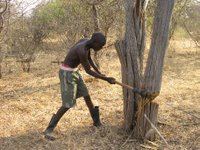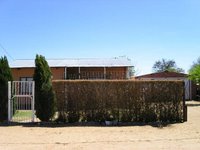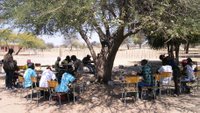 Returning home.
Returning home.
Wednesday, September 20, 2006
Work in school has started and it’s fantastic! There are some challenges though;
- We have 45 minutes (which always becomes less because they have no brake between classes) per class in a 7 day period.
- There is no changing room and no showers or facilities to wash (no toilet).
- The kids play in their school uniform, some in their black leather shoes and some barefoot.
- Some classes are 60 kids.
- All of our balls (which are very few) get flat in no time because of all the thorns and glass lying around.
- The youngest learners don’t know English (and I’m not that good (yet) in Oshiwambo and Damara (Etanga = ball)).
- The women teachers wear blouse, skirt and high heels in the sand!
It’s 100°C, and the sun is always shining. (This is spring, I can’t wait until summer!) - There is no evaluation of the students in P.E.
- The teachers actually don’t want to teach P.E. (or they wish I could just take the kids and leave them alone (not doing that though :))
Despite all of the above:
- We are having so much fun!
- The kids love me and I love them!
- The teachers love me (and hit on me) and I love them!
- I, the kids and the teachers learn a lot!
I have also a program in school where some of the older learners (grade 7-10) teach the younger learners (grade 1-4) P.E. It is working very well and they are very professional in their work.
The art exhibition on Namutoni Lodge was a success! Many of the children sold paintings for 300-500 N$ each! They also went for a game drive in the park. Many children continue making paintings to sell at the lodge. Some of the money will go to the school and some to the painter.
Today is “pay day” so many of the teachers jumped up in the back of Barney’s car and went to Tsumeb to burn some money. The teachers here have a quite high salary, around 4800 N$/month.
Kaliipo nawa! (Goodbye, see you later)
Saturday, September 09, 2006
NAM-VIP, art workshop and Cape Town
Ongeipi!
I am right now in
Two weeks ago we had a workshop in
Beatrice has led the art workshop and when I was leaving them Thursday morning a lot of good work had been done. When I am writing this the exhibition at the Namotoni Lodge in Etosha is already over. I hope it went well!
Here some facts (kind of):
The most common car manufacture by far is Toyota (everybody I have spoken to is very satisfied with their Toyota and means it is a very reliable car made for this harsh conditions), pickup model so the can load equipment and people – they always stop for hitchhikers and the hitchhikers always pay (this is actually making it possible for people to afford a car when petrol is a very big expense in Namibia because of the great distances between cities). Average speed on the straight roads is 120 km/h with a crappy car and 160-170 km/h with a good car.
In Oshivelo there are very few cars, not including the police and the army maybe only 3.
Pap - porridge from maize- or omahangumeal is THE food in









